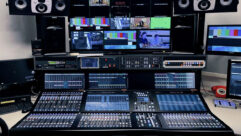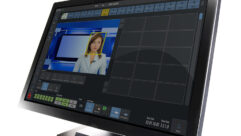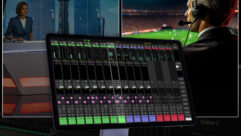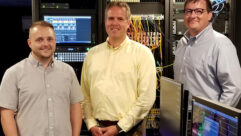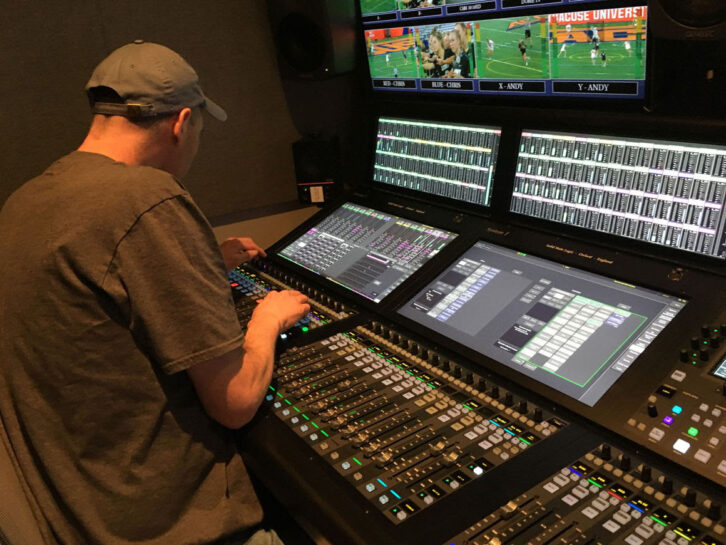

Syracuse, New York, February 20, 2024 — The S.I. Newhouse School of Public Communications at Syracuse University has upgraded all three broadcast audio production control rooms at its Dick Clark Studios with Solid State Logic’s System T broadcast production platform. The systems, which include two 48-fader S500 surfaces and a 32-fader S300 surface, support the school’s television, radio and film curriculum and are also being used to produce programming for ESPN’s ACC (Atlantic Coast Conference) Network and the university’s Orange Television Network. System T was selected for its flexible routing, ease of configuration, and sound quality.

The university’s athletics teams, known as the Syracuse Orange, have participated in the Atlantic Coast Conference for almost a decade and are members of the NCAA or National Collegiate Athletic Association’s elite Division 1. “We’ve probably had more Tier 1 games than any other school; we produce about 120 games a year for ESPN / ACC Network,” reports Neal Coffey, Manager of Operations and Engineering for Dick Clark Studios and an Adjunct Professor on the Television, Radio and Film program at the Newhouse School. “We’re almost like a small regional sports network.”
Dick Clark Studios and Orange Television Network
One System T S500 control surface has been installed in audio control room ACR1 at the school’s Dick Clark Studios, which is named for legendary entertainer and Syracuse University alumnus Dick Clark, who graduated in 1951. The room is used to mix audio for all the facility’s ACC Network game coverage for ESPN as well as student-produced programming for campus cable’s Orange Television Network, such as Live from Studio B, a Sunday night variety show, and also Loud & Clear, a Friday night music show. The second S500 control surface has been integrated into ACR3, a newly constructed audio suite within production control room PCR3. The new room will enable the facility to handle two ESPN games simultaneously for the first time. The S300 is integrated with Ross Overdrive automation in ACR2, which is a fully automated room.

At its most basic, Broadcast Engineer Tom White says, “The console is very simple, very flexible and allows us to do any type of show — sports, music, studio — and switch between the modes of operation. But it also has a lot of other bells and whistles that you don’t normally get with other consoles right out of the box. As for sound quality, you can’t beat it. I love it.”
On the first day of operation, producing a soccer match doubleheader for broadcast at the start of the fall 2023 semester, Coffey says, “What was interesting is that one of the guys who was working in the production control room came in and said, ‘This really does sound better, doesn’t it?’ We didn’t have to wave a flag; people really noticed it.”
In terms of specific features and functionality, White says, “I love the menu structures. Plus, the simplicity of the routing, the simplicity of the internal routing of stems, VCAs, and groups, the Query function, and everything you can do with this console with just a couple of button pushes is amazing. The meter bridge, and all the different little things that you can do in the meter bridge, was a huge thing for us.”

An educational tool and sonic parity among control rooms
For Coffey and the staff, KVM has also been key, in Coffey’s case for controlling the Enco Digial Audio Device playback during broadcasts, he says. But one of the main reasons to like System T is its flexibility as an educational tool, Coffey comments. “We can simplify the look of the console so that when students first sit down, they’re not overwhelmed by all the functions, the dynamics, and other stuff. Then we can build on their skill sets, once they are comfortable with the number of faders in front of them.”
Coffey also notes, “One of the reasons why we went with the combination of the S300 and the two S500s was so that we could have parity among our control rooms. We have three production control rooms that students will be floating between. Obviously, when we’re broadcasting games, typically there’s a professional A1 sitting there. But students can take that experience into one of the other rooms when we’re not doing such a high-level show and hopefully share that experience with others.”
“With our two S500s, as an example, we’ll have a show going on in PCR1, with our full crew,” says Patrick MacDougall, Senior Audio Engineer, Studios-Post Production. “I plan on having interested students shadowing in PCR3, so we will be able to mix a show separately. We could do our own production of the show, listening to the director and producer calls and any other information, but in a less pressurized situation, because it isn’t on the air.”
“I call it the side-by-side model,” Coffey adds, “where we take all those incoming audio and video signals and route them to the smaller production control room. From a mixing standpoint, the nice thing is that the two S500 consoles are identical for that teaching purpose.”

Leveraging System T’s Dante integration
Newhouse’s Dick Clark Studios had been using Dante for some time, but the main mixing console previously installed could not be fully integrated into the network. White comments, “When we decided to really look at System T that was one of the things that intrigued all of us the most, because this is a Dante-native console,” he says. “Then, when we designed the system, it made it simple because we didn’t have to worry about adapting the console to our current systems. It was just going to drop right in. All of us were familiar with Dante Controller already but the fact that the System T has its own Dante control all from within the console, is just fabulous.”
The department had also been using enterprise network switches previously, White continues. “Knowing that we could just use business class switches with System T really lit my fire. So, the integration was fairly simple, and with the help of SSL’s engineers we were able to get the first one, the S300, up and running with little to no issues. Then, when we went to put the S500s in, because we had that experience with the S300, it all really went smoothly.”
About Solid State Logic
Solid State Logic is the world’s leading manufacturer of analogue and digital audio consoles and provider of creative tools for music, broadcast, live and post production professionals. For more information about our award-winning products, please visit: www.solidstatelogic.com.


